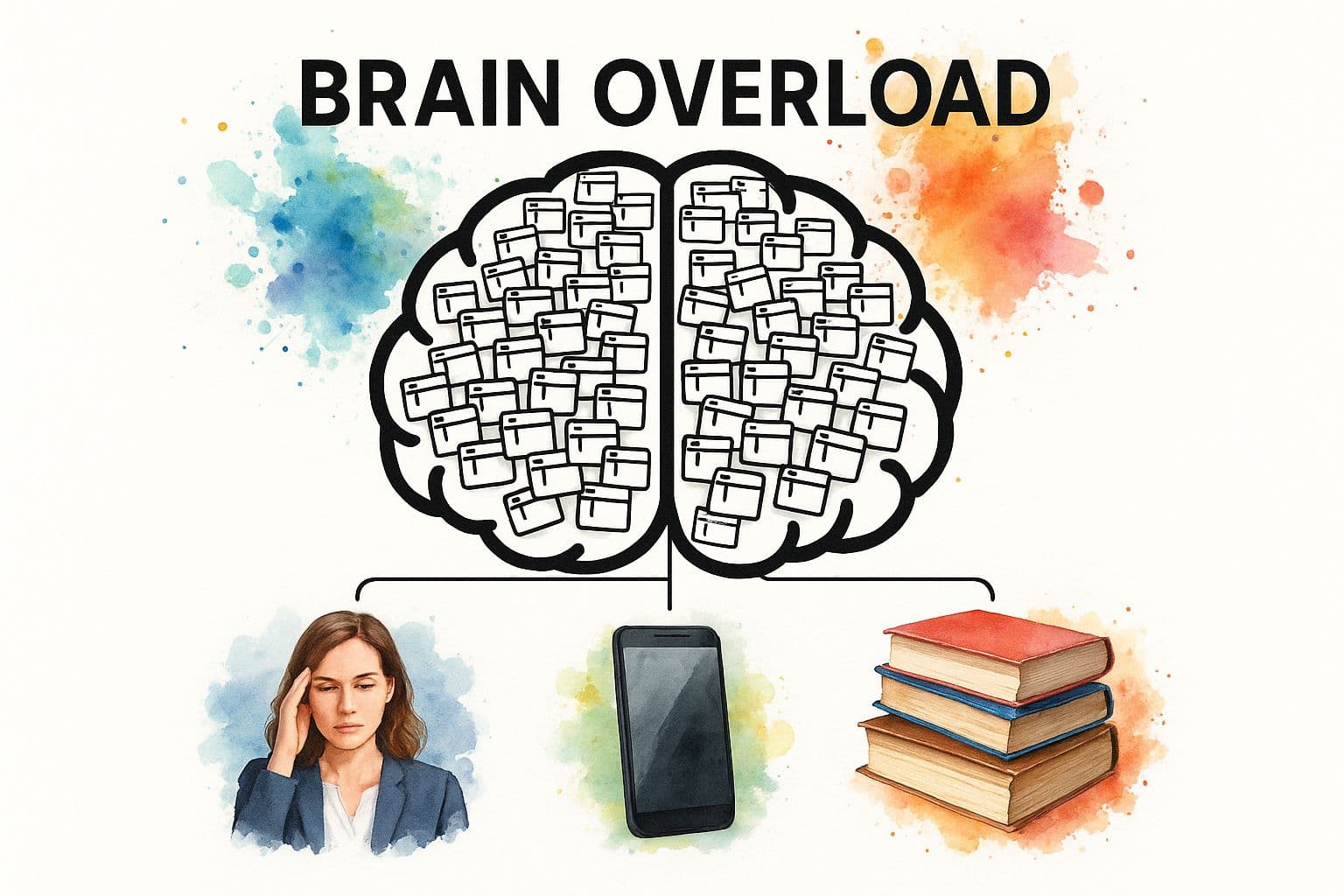Wondering what is cognitive overload? Learn how to recognize the signs and discover effective strategies to reduce mental fatigue today!
October 9, 2025 (1mo ago)
What is Cognitive Overload? Understand & Manage Mental Fatigue
Wondering what is cognitive overload? Learn how to recognize the signs and discover effective strategies to reduce mental fatigue today!
← Back to blog
Ever find yourself staring at a screen with a million tabs open, trying to answer an email while a Slack notification goes off, all with a big deadline breathing down your neck? If your computer did that, it would slow to a crawl. That’s pretty much what cognitive overload does to your brain.
It’s not a sign of weakness or that you can't focus. It's just what happens when your brain is forced to process more stuff than it’s built to handle at one time.
Your Brain on Overdrive: Understanding Cognitive Overload
At the heart of this whole thing is your working memory**. You can think of it as your brain's RAM—it’s the mental space where you juggle whatever you're working on right now. The catch? This workspace is powerful, but it's also surprisingly small.
Most research says our working memory can only hold on to new info for about 15 to 30 seconds before it's either filed away into long-term memory or just disappears. When we try to cram too much in, our brainpower takes a nosedive. We start missing things, making mistakes, and feeling totally drained.
This infographic does a great job of showing how our brain’s limited capacity gets swamped by the endless flow of data in modern life.

As you can see, it's not any single piece of information that's the problem—it's the sheer amount of it all hitting us at once.
The Core of the Problem
So, what is cognitive overload really? It’s the point where the demands on your attention are bigger than your brain’s available processing power. It creates a mental traffic jam, stalling your ability to think clearly and get things done.
Cognitive overload is the point where the brain’s processing power is saturated, making it difficult to learn new things, make decisions, or solve complex problems effectively.
To break it down even more, here's a quick look at what's going on under the hood.
Cognitive Overload at a Glance
| Component | Description | Real-World Example |
|---|---|---|
| Working Memory | Your brain's temporary "scratchpad" for holding and manipulating information for immediate tasks. It has a very limited capacity. | Trying to remember a phone number someone just told you while you look for a pen and paper to write it down. |
| Information Input | The constant stream of data, tasks, and stimuli you receive from your environment. | Reading emails, listening to a podcast, getting app notifications, and having a conversation—all at the same time. |
| Processing Capacity | The finite amount of mental effort or "bandwidth" you have available at any given moment to process incoming information. | Feeling fresh and focused at the start of the day, but mentally exhausted and unable to solve simple problems by 3 PM. |
| Overload State | The tipping point where information input overwhelms your processing capacity, leading to a decline in cognitive function. | Finding yourself rereading the same paragraph five times without understanding it because your mind is too cluttered. |
This table helps show that cognitive overload isn't just about feeling "busy." It's a specific neurological state where you're just full up.
Feeling constantly scattered, frazzled, and like you can't get traction on important work is a big sign you're deep in this state. The key isn't just better time management; it's about actively managing your mental energy.
The good news? Once you learn to spot the signs and understand the causes—which we’ll get into next—you can take back control.
Recognizing the Sneaky Signs of Mental Saturation

Cognitive overload doesn't just show up and announce itself. It creeps in, often disguised as just a bad day or a temporary slump. But if you know what to look for, you can spot the clear signs that your brain has hit its limit, slowly chipping away at your ability to do your best work.
Imagine a project manager—we'll call her Sarah—who starts her morning with a clear, perfectly organized to-do list. She feels like she's on top of the world. By 10 AM, though, her inbox is a disaster, notifications are pinging nonstop, and her calendar is a wall of back-to-back meetings.
Her proactive plan quickly turns into a day of reactive firefighting. She’s bouncing between tasks—drafting an email, hopping on a call, skimming a document—without ever really finishing anything. By noon, she’s drained but feels like she’s gotten nothing done. This isn't just a busy day; it's a textbook case of mental saturation.
The Tangible Symptoms of Overload
That feeling of being completely swamped is just the tip of the iceberg. When your working memory is constantly stretched thin, the fallout shows up in very specific, tangible ways. Spotting them is the first step toward getting back in control.
Keep an eye out for these common red flags:
- Decision Fatigue: You find it hard to make even small choices, like which task to tackle first or what to grab for lunch. Every decision feels like a heavy lift because your brain has no processing power left to spare.
- Constant Task Switching: You open a spreadsheet to focus, get pulled away by a Slack message, and then completely forget what you were doing in the first place. This frantic cycle leaves a trail of half-finished work and zero progress.
- Increased Irritability: The smallest thing—a slow-loading page or an unexpected question—triggers a huge wave of frustration. Your patience is shot because your mind is already maxed out.
- Noticeable Drop in Problem-Solving: A problem you could normally solve in your sleep suddenly feels impossible. Your ability to think creatively and critically just vanishes as your brain shifts into survival mode.
The real issue isn’t a lack of effort; it’s a lack of available cognitive resources. When your brain's processing queue is full, every new bit of information feels like a threat instead of an opportunity.
From Subtle Signs to Clear Patterns
These symptoms rarely show up one by one. They tend to pile on, creating a vicious cycle that’s tough to break. You might start noticing more careless mistakes in your work or a persistent brain fog that sticks around long after you’ve shut your laptop for the day.
If Sarah’s chaotic morning sounds familiar, or if the symptoms above hit a little too close to home, it's a strong sign you're not just "busy." You’re experiencing cognitive overload—a state where your brain’s processing power is completely maxed out. Recognizing this difference is key, because you can't fix a capacity problem with willpower alone.
Why Our Brains Are Hitting a Wall
If you feel like you're constantly hitting a mental wall, you're not alone. It's easy to blame yourself, to think it's some personal failing, but the truth is our modern world is almost perfectly designed to overwhelm our brains. That feeling of burnout isn't just in your head—it’s a direct response to an environment that demands way more attention than we can possibly give.
So, what’s really going on? The causes of cognitive overload are varied, but they usually come down to three main culprits. Each one acts like a tiny leak in your mental fuel tank, slowly draining your resources until you're running on empty.
The Endless Information Firehose
First off, we're swimming in a sea of information. Just think about it: your phone, your laptop, your watch—they all unleash a relentless flood of notifications, emails, news alerts, and social media updates. Every single ping is a tiny interruption, a small demand for your attention that yanks you away from what you’re trying to focus on.
This constant stream of data forces your working memory to work overtime. It has to stop and evaluate every new piece of information that comes in. Is this important? Do I need to act on this now? Can it wait? This filtering process is mentally exhausting and leaves very little bandwidth for the deep, focused work that actually matters.
The Myth of Multitasking
The second big cause is the cultural pressure to juggle a dozen things at once. We've been sold this idea that multitasking is a superpower, but our brains are fundamentally built to do one thing at a time. When we think we're multitasking, we're really just switching our attention back and forth at high speed.
This constant mental gear-shifting, better known as context switching, comes at a high cognitive price. Research shows that even a brief interruption can completely derail your focus, taking you up to 20 minutes to get back on track. We've written a detailed guide on this hidden productivity killer, which you can read here: https://fluidwave.com/blog/what-is-context-switching. Every time you switch, you're draining energy and dramatically increasing the odds of making a mistake.
The persistent belief that we can effectively multitask is one of the biggest contributors to modern cognitive overload. In reality, it just fragments our attention and ensures we do multiple things poorly instead of one thing well.
Environmental Triggers and Interruptions
Finally, our surroundings—both physical and digital—are often full of distractions. That open-plan office might seem great for collaboration, but the constant background chatter and visual noise can make it nearly impossible to concentrate. Then you have the endless, unscheduled meetings and the "just a quick question" interruptions that shatter your flow and force your brain to hit the reset button over and over again.
This problem isn't just in corporate offices, either. Think about healthcare, where doctors have to manage huge amounts of patient data and make high-stakes decisions under immense pressure. It's a textbook example of an environment that pushes working memory to its absolute limit, leading to widespread cognitive overload and burnout.
Understanding these root causes is the first real step toward getting your focus back. For a deeper look into this, it’s worth exploring what causes brain fog and how it affects your day-to-day thinking. Once you can spot the triggers, you can start building a work environment that supports your brain instead of constantly fighting against it.
The Hidden Costs to Your Productivity and Well-Being
Cognitive overload isn't just a fleeting moment of stress—it's a silent killer of productivity and well-being. When your brain is constantly juggling too much information, it’s not just an uncomfortable feeling; it actively gets in the way of you doing your best work. That mental fog leads to simple, avoidable mistakes and can completely shut down creative problem-solving.
Imagine your brain has two gears. In the right gear, it's proactive, innovative, and ready to tackle complex problems. But when overloaded, it slams into a reactive, survival mode. You're no longer steering your day; you're just trying to keep your head above water. This constant mental firefighting makes you far more likely to miss deadlines—not because you're not trying, but from sheer cognitive exhaustion.
Beyond the To-Do List: The Impact on Your Health
The damage doesn't stop when you log off. The persistent strain of cognitive overload is a huge driver of burnout, taking a serious toll on your personal life. It's hard to feel good about your job when every single day feels like an uphill battle against an avalanche of tasks and information.
Tackling cognitive overload isn't just a personal productivity hack; it’s a critical business challenge. Ignoring it leads to a direct hit on both individual success and overall organizational health.
This chronic mental exhaustion inevitably spills over, souring your mood, straining relationships, and making it impossible to truly switch off. It also feeds directly into a related issue: decision fatigue. When you're forced to make too many choices, your mental energy just evaporates. You can explore this more in our guide on what is decision fatigue.
The Organizational Price of Mental Strain
This problem is especially intense in demanding fields like tech, where teams are under constant mental pressure from complex projects and the never-ending need to learn new things. In these high-stakes environments, the connection between mental overload and negative outcomes is crystal clear.
The research paints a stark picture. There's a strong link between teams drowning in high cognitive load and skyrocketing burnout rates. In fact, a staggering 76% of overloaded team members report feeling burned out. It's no surprise that this also fuels a 68% increase in turnover intention, as talented people look for environments that won’t completely drain them. By getting a handle on cognitive load, companies can protect their most important asset: their people.
Actionable Strategies to Reclaim Your Mental Space

Realizing you're in a state of cognitive overload is one thing; actually fighting back against the constant noise is another thing entirely. The secret isn't to just "try harder." It's about deliberately using strategies that carve out the mental breathing room you need for deep, focused work.
Think of it as designing an environment that works with your brain's natural limits, not against them. These techniques aren't complicated, but they do require a conscious shift away from the chaotic, "always-on" default we've all gotten used to.
Embrace Single-Tasking with the Pomodoro Technique
If there's one major culprit behind mental fatigue, it's the myth of multitasking. The most powerful antidote is simple: commit fully to one task at a time. The Pomodoro Technique gives you a great framework for making this happen.
Here’s the simple-but-effective process:
- Choose One Task: Get specific. Don't just "work on the project." Instead, decide to "draft the introduction for the quarterly report."
- Set a Timer for 25 Minutes: For the next 25 minutes, that one task is your entire world. No peeking at email, no checking your phone. Just pure focus.
- Take a Short Break: When the timer dings, you're done—for now. Step away from your desk for 5 minutes. Stretch, grab some water, and let your brain reset.
- Repeat and Rest: After four of these focused sessions (or "Pomodoros"), take a longer break of 15-30 minutes. You've earned it.
This method works so well because it transforms overwhelming projects into a series of manageable, focused sprints, preventing the mental drift that fuels overload.
Prioritize Ruthlessly with the Eisenhower Matrix
Let's be honest: not all tasks are created equal. When everything feels urgent, you lose the ability to tell what’s actually important from what’s just making noise. The Eisenhower Matrix is a classic decision-making tool that helps you cut through the clutter by sorting tasks based on two simple things: urgency and importance.
The whole point is to spend less time reacting to trivial demands and more time investing in what truly moves the needle. This framework forces you to pause and think before you act.
Here’s how to sort your to-do list:
- Urgent and Important (Do): These are the fires you need to put out now. They have immediate deadlines and real consequences. Tackle these first.
- Important, Not Urgent (Schedule): This is where your real goals live. These tasks contribute to long-term success but don’t have a looming deadline. Proactively schedule them to make sure they happen.
- Urgent, Not Important (Delegate): These tasks demand attention now but don't require your unique skills. This is where you delegate. Fluidwave’s platform is perfect for this, letting you offload work to skilled virtual assistants.
- Neither Urgent nor Important (Delete): These are the distractions and time-wasters. Be ruthless and get them off your list entirely.
Create an Information Diet and Master Your Schedule
Finally, winning this battle means becoming the gatekeeper of the information you let in. An information diet is just what it sounds like—consciously limiting your exposure to stuff you don't need. This could be as simple as turning off notifications, checking email only at set times, or unsubscribing from newsletters you never actually read.
Pairing this with a structured schedule is a game-changer. For example, using a time-blocked calendar helps you dedicate specific chunks of your day to deep work, meetings, and admin tasks. Exploring different strategies to reduce chronic stress can also be a huge help, as these practices go hand-in-hand with an organized workflow. When you control both what comes in and how you spend your time, you build a powerful defense against cognitive overload.
Rethinking How We Learn and Retain Information
https://www.youtube.com/embed/KlbsuPAibfY
Ever sat through a long training session, only to realize a week later that you can barely remember the key points? It’s an incredibly common experience, and it’s a direct result of cognitive overload. When we try to force too much information into our minds at once, we’re not just making learning tedious—we’re making it completely ineffective.
This happens because our working memory, the mental scratchpad we use for processing new information, has some very real limits. Pushing past those limits doesn't create better recall; it just leads to mental exhaustion and forgotten lessons. To truly make knowledge stick, we have to start working with our brain's natural design, not against it.
The Forgetting Curve in Action
One of the biggest hurdles in learning is a well-known phenomenon called the "forgetting curve." First studied by psychologist Hermann Ebbinghaus, this concept shows just how quickly our brains ditch new information if it isn't actively reinforced.
The numbers are pretty shocking. Research shows that people forget roughly 50% of new information within an hour, 70% within a single day, and an astonishing 90% within just one week. In a corporate training setting, this means the vast majority of your investment is vanishing almost immediately. You can find more details on how modern companies are tackling this challenge in this speach.me article.
This rapid memory decay is exactly why traditional, marathon-style learning sessions so often fall flat. They completely overwhelm our cognitive capacity, making it nearly impossible for new concepts to move from our fragile, short-term working memory into durable, long-term storage.
Brain-Friendly Learning Strategies
So, how do we get around our natural tendency to forget? The solution is to adopt smarter, more strategic approaches that respect our cognitive limits. Instead of information dumps, we need to embrace methods that deliver knowledge in ways that are easy to digest and retain over time.
The goal isn't just to present information; it's to ensure that information gets properly encoded into long-term memory. This requires a fundamental shift from a "more is better" mindset to a "smarter is better" one.
Here are two powerful, brain-friendly techniques that make a real difference:
-
Microlearning: This strategy is all about breaking down complex topics into small, highly focused, bite-sized modules. Instead of a two-hour webinar, imagine a series of self-contained five-minute videos. This approach prevents cognitive overload by delivering just enough information to be absorbed without overwhelming your working memory.
-
Spaced Repetition: Rather than cramming everything in one go, this technique involves revisiting information at increasing intervals. By strategically re-engaging with the material over time, you send a clear signal to your brain that this knowledge is important and needs to be kept, effectively fighting back against the forgetting curve.
Got Questions? We've Got Answers
Let's clear up a few common points of confusion around cognitive overload and how it really affects your work and well-being.
Is Cognitive Overload Just Another Word for Burnout?
Not quite, but they're definitely related. Think of it this way: cognitive overload is that constant, frantic feeling of having way too many tabs open in your brain at once.
If you live in that state for too long, it becomes a fast track to burnout—a much deeper, more severe state of complete mental, physical, and emotional exhaustion. Tackling cognitive overload is one of the most powerful ways to stop burnout before it starts.
Can't I Just Fix This with Better Time Management?
If only it were that simple. Time management is a great start, but it's only part of the solution. You can schedule your day down to the minute, but that doesn't change the actual amount of information you're trying to process or the complexity of the tasks on your plate.
A real fix means taking a broader look at how you work. It involves reining in your information diet, simplifying your workflows, and building an environment that actively shields you from distractions.
You can’t organize your way out of a capacity problem. Effectively managing cognitive overload is about reducing the mental load itself, not just scheduling it better.
How Can Managers Help Their Teams Deal with This?
Managers are on the front lines of this battle and can make a huge difference. The single most impactful thing a leader can do is to ruthlessly prioritize tasks.
Beyond that, actively protect your team's focus. That means cutting down on "just in case" meetings and streamlining those chaotic communication channels. Fostering a culture where people feel safe to disconnect and recharge is also massive.
Giving your team clear direction and a manageable workload will always beat telling them to "manage their time better."
Ready to stop juggling and start delegating? Fluidwave combines smart task management with skilled virtual assistants to clear your plate and restore your focus. Discover how Fluidwave can help you today.
Focus on What Matters.
Experience lightning-fast task management with AI-powered workflows. Our automation helps busy professionals save 4+ hours weekly.